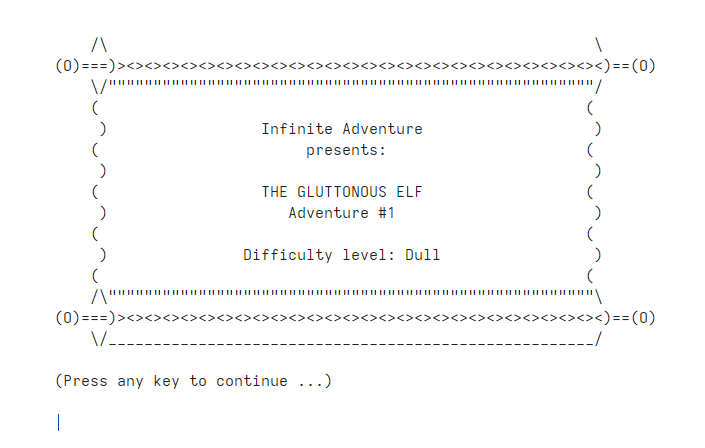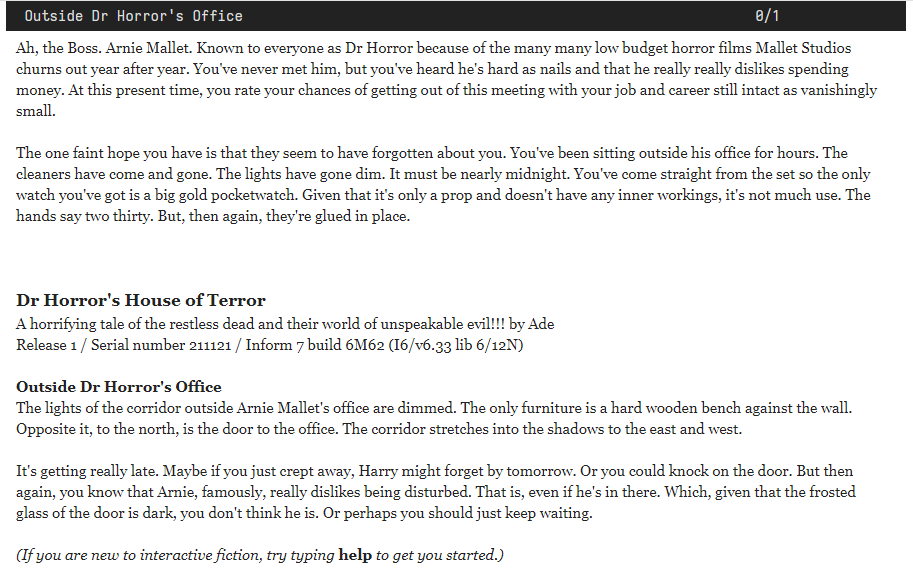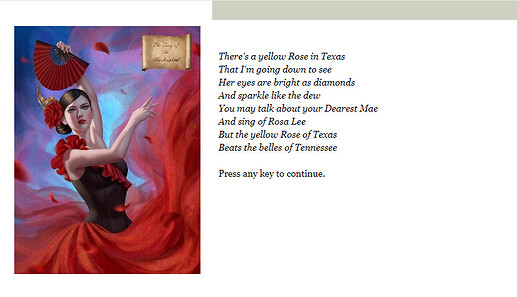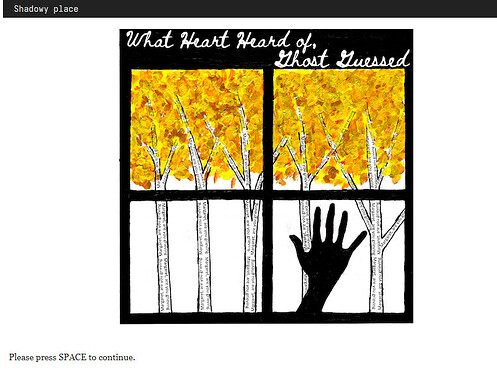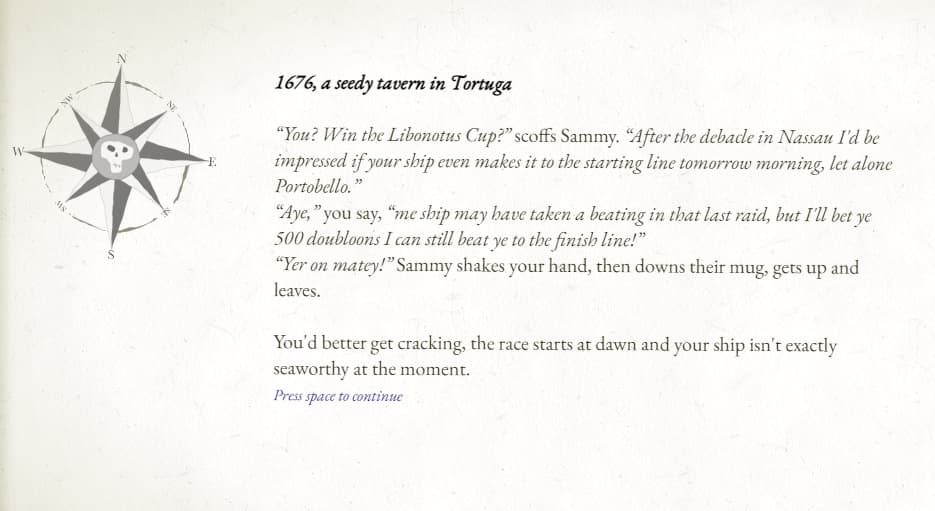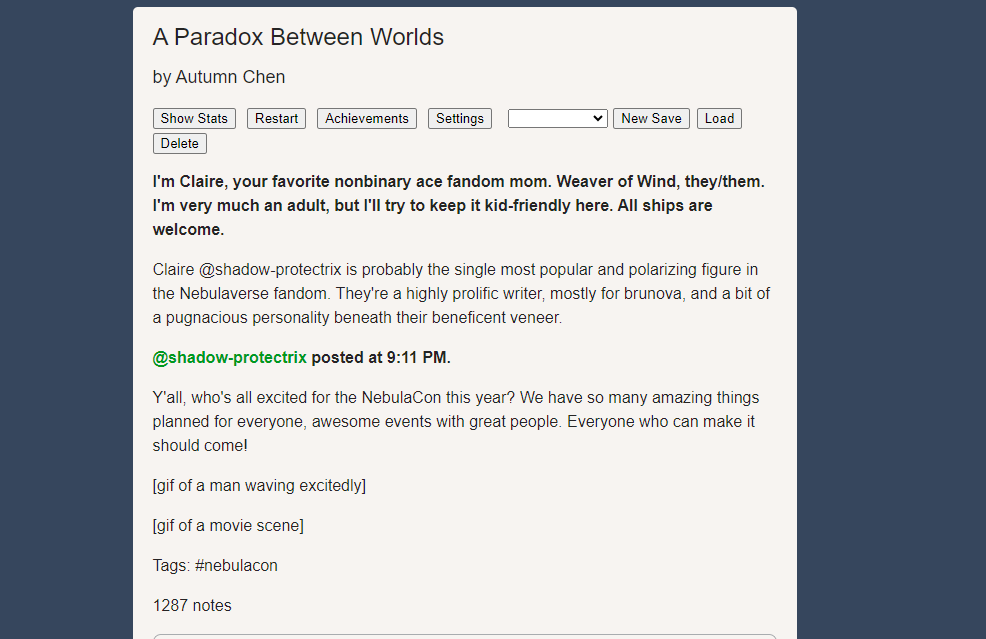Overview and Influences
Coming after the largest comp ever, this IFComp had a more manageable 71 games. In contrast to the trends of the recent past, this year had more highly-rated parser games and what feels like more parser games in general. Six of the top 10 were parser. However, the variety in the parsers used was high; this year had two Adventuron games, several custom parser games, a Dialog game, multiple Quest games, and a TADS game.
While this was an especially fruitful year for parser games, the choice-based games were in no way diminished. Long-term authors like Agnieszka Trzaska and Autumn Chen entered games which I consider some of the best in their oeuvres, and new authors like Charm Cochran appeared who would go on to contribute a lot later on.
There doesn’t seem to be a strong theme running through games this year or significant influence from real-life events like Covid.
This year had several rule changes, most significantly that authors could now vote as judges! This was put in place to address complaints that the number of games and authors had outpaced judges so that games were getting very few votes. The rule change ended up working out well, and is still in place. It’s possible that the higher rankings of parser games was influenced by the author vote, but we’ll see that 2022’s results render that unlikely.
Another rule change was to have an award for a ‘Rising Star’, to highlight the highest-placing game by a first-time entrant.
The influx of parser games and the smaller number of entries may have been influenced by the Parser Comp which ran for this year. First run in 2015, it was revived in 2021 by new organizers and had a fruitful year. I would have thought that having a separated competition for parser games would have drawn off some games from IFComp and, indeed, the number of entries is lower; but I also would have thought it would lower the number of parser games in IFComp, and that did happen.
Other notable games released before IFComp in 2021 include Excalibur by J. J. Guest, G. C. Baccaris, and Duncan Bowsman, which was a fictional wiki describing a piece of lost media, and the game The Weight of a Soul by Chin Kee Yong, which is an alchemy fantasy steampunk game and one of the few games to have been entered in Spring Thing twice (once as a Back Garden demo and once as a full game).
Top Games
And Then You Come to a House Not Unlike the Previous One
and
Infinite Adventure, both by BJ Best
This game was entered as part of a pair of games in IFComp. The game that accompanies it is a DOS-only game called INFINITE ADVENTURE that has procedurally generated, simplistic adventures of the ‘take item in room A to unlock chest in room B to give item to NPC in Room C’.
The actual game is a complex Inform game that tells the story of two kids playing Infinite Adventure before one of them has to move away forever. In a way reminiscent of Endless, Nameless, there are multiple layers to the game; you can be playing Infinite Adventure (or another game) while simultaneously talking to your friend.
I think one reason this game was (and is) so popular is that it works on several levels covering a broad range of people interested in IF.
*The base layer of the game is a lot of fetch quests, hopping from one computer application to another. It satisfies the original ‘parser itch’ of wanting to pick up things and solve puzzles. Instead of making puzzles super easy, each puzzle has two solutions or more, so players have more chances to feel smart by stumbling on a solution.
*The ‘conversation layer’ uses a menu system and goes in-depth with good writing, satisfying people that are into games for the dialogue or are used to choice-based games.
*The ‘meta puzzle’ layers of ‘what is actually going on with this game?’ and ‘how does the other game tie in?’ satisfy fans of the late 90’s/early 2000’s school of symbolic gameplay.
It turns out that you can get ideas from the main game on what to type into the DOS game, which gives you a command you can use back in the main game. Pretty neat!
Dr Horror’s House of Terror
by Ade McTavish
I really like Ade McTavish’s work. I started interacting with IFComp a year after his game Fifteen Minutes, and I enjoyed Map in 2015. Since then, he’s released numerous polished games.
This one came very close to winning, with only a .08 or so difference in scores. It’s a parser game set on a B-movie studio lot, with several little studio buildings clustered around a courtyard. Each studio has its own setting, puzzle type and themes. For instance, one has a travelling menace and is themed around old Europe; another is Egyptian themed and relies on animals.
This game still has relatively few reviews now, several years later. I think it deserves a few more!
The Song of the Mockingbird
by Mike Carletta
The Western is one of the most neglected genres in IF. While there are some notable highlights like Gun Mute and You Will Select a Decision, there are less than 60 Western games listed on IFDB out of several thousand.
This is a great example of the genre, with gunfights, a hero left in a hopeless situation, the glimpse of new technology right around the corner threatening the western way of life, and a hopeless love.
The gameplay is technical and more difficult than the other parser games, with tricky mechanisms and puzzles that require a lot of thinking. And singing, too.
Reviewers noted the difficulty inherent in the game and its solid writing and serious tone.
Other Games
What Heart Heard Of, Ghost Guessed
This was the debut game for Amanda Walker, and it went on to win the Best Game XYZZY Award. She went on to author numerous games in the last few years and is one of the most successful current authors in terms of nominations and wins for the XYZZY awards and the IFDB Awards.
Amanda Walker’s unique feature is her use of poems as source material for games. Many of her games are direct adaptations of poems, with key figures and puzzles taken from them. Other games are based on faery tales or prompts from others.
This particular game has you play as a ghost with limited capacity to interact with the surrounding world. By exploring objects that have memories associated with them, you learn new emotions and act on objects through those means. The story itself is classic gothic, with hidden evil, isolation, and of course a big creepy house.
The Libonotus Cup
by Nils Fagerburg
This interesting game uses a custom javascript engine to enable a parser/choice hybrid interface with nice text styling. The game itself is lighthearted, with a pirate-themed sailing race and a variety of puzzle mechanics. It’s a relatively rare example of a custom parser engine that feels as good as the traditional ones (Inform, TADS, etc.)
A Paradox Between Worlds
by Autumn Chen
This Choicescript game does a lot of interesting things. Perhaps most surprisingly, it simulates Tumblr, letting you follow a bunch of different people and choose what to reblog and not. It puts you in a fandom for a fictional series, and part of the game involves you roleplaying in the series-within-the game, giving you two layers of gameplay. It also covers a fictional version of JK Rowling’s progressively stronger anti-trans statements and how that affects the community.
Sting
by Mike Russo
This game is a very polished autobiographical game in a linear and mostly (but not entirely!) puzzleless style. In many ways it’s reminiscent of IF from the early 2000’s like Photograph by Steve Evans or Emily Short’s Best of Three, with its intense focus on the details and emotions of realistic situations (I’m not sure what word I’m looking for here; literary? hyper-realistic? non-magical realism?). One example is the following exchange:
>l
Back Yard
The back yard of your family’s house is really big. The garden, with a pagoda, is on one side, the swing set is on the other, and a fence runs around it. The back door goes into the kitchen, and you could go north past the house to the front yard except you’re not supposed to go there by yourself.Liz is here, sticking out her tongue at you.
>play swings
Wait, there wasn’t a swing set yet when this happened – my mistake.
The way that every description is used to make a point or to tell an emotion really reminds me of that early period, and of course of Photopia. I remember reading advice from Adam Cadre that every response the player gets should be rewarding in some way.
The autobiographical/retrospective nature is unusual, although a few other games had explored similar concepts (such as 2019’s Meeting Robb Sherwin by Jizaboz or Ryan Veeder’s Rope of Chalk in 2020). But its combination of all these elements is unique, making it one of the most unusual games of the last few years.
we, the remainder
by Charm Cochran
This was the first Charm Cochran game I played. While it didn’t place as highly as some of the games on this list, it stuck with me. It is a Twine game that uses a kind of textual compass rose to navigate around.
It’s full of religious imagery, dealing with the aftermath of a cult and its actions. Lots of surrealness. Charm has gone on to make many games that have similar strong emotional cores with surreal, often religious imagery.
Assorted Others
Some other games I’d like to mention in passing:
- Cygnet Committee by PB Parjeter contains live action archival black and white footage.
- Sarah Willson made her debut with Closure, a very technically impressive and well-written game where a parser is presented visually as text messages and in-game as you communicating with someone exploring their ex’s dorm room.
- Off-Season at the Dream Factory was a third (!) game entered this comp by BJ Best written in Adventuron and using several heavily pixelated photos from cosplay sites.
- The Vaults was a roleplaying game with gems and microtransactions (that were turned off at the time) that is now on Steam.
- Universal Hologram used early AI art models. At that time, AI art was noticeably non-realistic and generally had severe deformities or issues, which was perfect for a surreal game. Many reviewers praised the AI art, which was a novelty. It wouldn’t be until later years that the art would get more controversial.
- Stephen Bond, author of Rameses from decades ago, came back with The Best Man, a psychologically gripping examination of ‘nice guys’.
- D’Arkun, by Michael Baltes, is one of the few full-length Dialog games in existence.
- Bizarrely, there were two games about assembling a rock band to use the power of music to stop people from being mind controlled: AardVarK Versus the Hype, by Truthcraze, and * Codex Sadistica: A Heavy-Metal Minigame*, by grave snail games.
Legacy
Many new authors entered this competition who later became very prolific or had solid, popular games (such as Amanda Walker, Charm Cochran, Sarah Willson, Travis Moy, and several others).
Dr Horror’s House of Terror directly influenced my level design when I wrote Never Gives Up Her Dead, with the idea of separate chunks of game that each have their own setting and puzzle style, with the protagonist travelling between them.
And Then You Come to a House Not Unlike the Previous One seemed to have spawned an entire subgenre of nostalgia games where the PC is playing an older game on a computer while commenting on it to others or otherwise having some ‘modern’ framing. Later examples include Repeat the Ending by Drew Cook and Hand Me Down by Brett Witty.
The generally accepted use of AI art in Universal Hologram is in stark contrast to the later backlash against AI once it became capable of accurately recreating many artist’s styles. 2022 would have many games with AI art covers.
There are plenty of other great games from 2021’s IFComp. If you feel I missed one, let me know down below!
Made with the support of the Interactive Fiction Technology Foundation
